Lewin Benjamin (ed.) Genes IX
Подождите немного. Документ загружается.

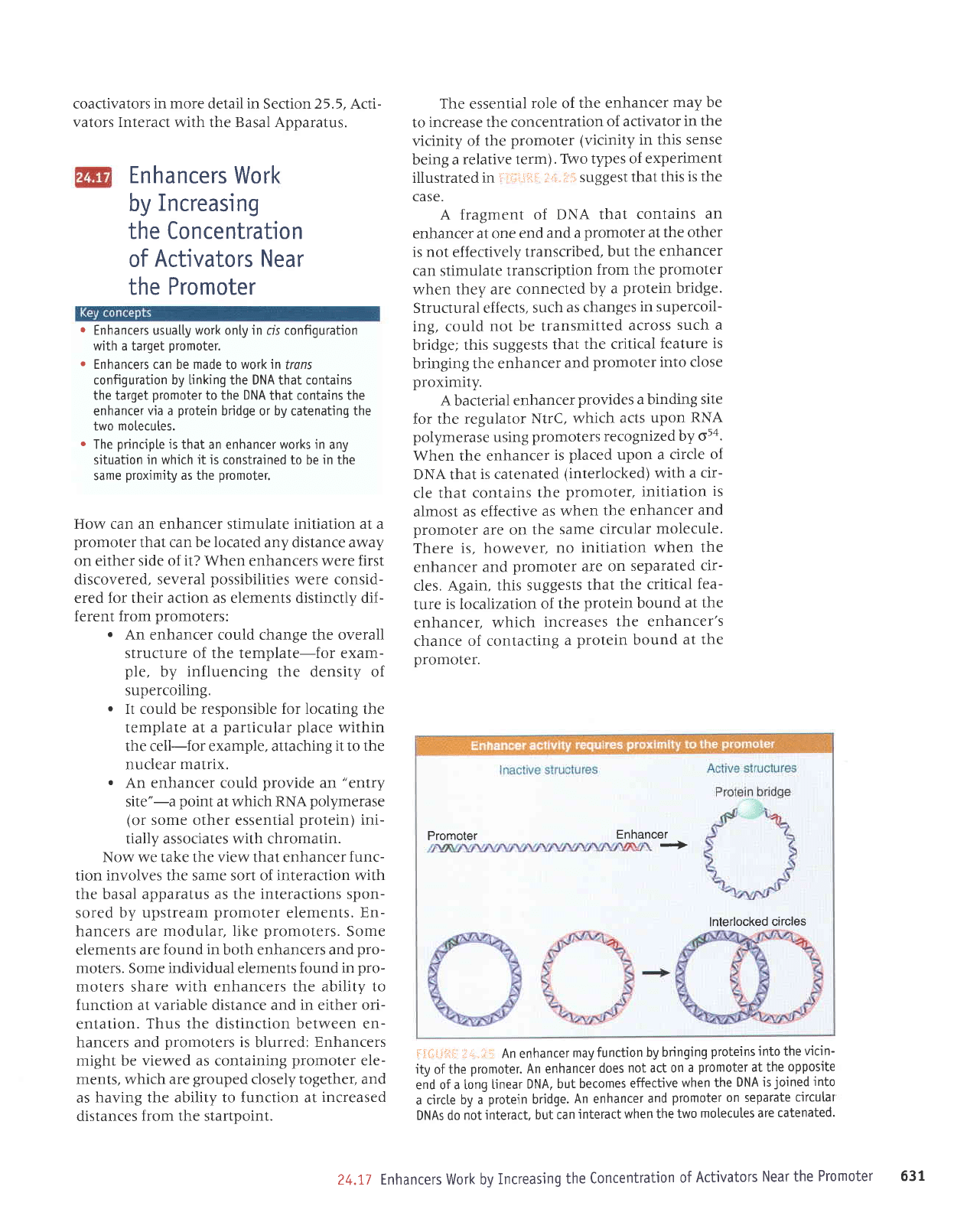
Enhancers
Work
by
Increasing
the Concentration
of
Activators Near
the
Promoter
.
Enhancers usuatly work onty in crs configuration
with a target
promoter.
.
Enhancers can be made
to
work in
trans
configuration by tinking the DNA that contains
the target
promoter
to the DNA that contains the
enhancer
via a
protein
bridge or by catenating the
two molecutes.
.
The
princip[e
is that an enhancer works in
any
situation in which it is constrained to be in the
same
proximity
as the
promoter.
How can an enhancer stimulate initiation at a
promoter
that can be located
any distance away
on either side of
it?
When enhancers were first
discovered,
several
possibilities
were
consid-
ered for their action as elements distinctly dif
-
ferent from
promoters:
.
An enhancer could change the overall
structure of the template-for exam-
ple,
by
influencing
the density of
supercoiling.
.
It could be responsible for locating the
template
at
a
particular place
within
the cell-for example, attaching
it
to
the
nuclear
matrix.
.
An enhancer could
provide
an
"entry
site"-a
point
at which RNA
polymerase
(or
some other essential
protein)
ini-
tially associates with chromatin.
Now we take the view that enhancer
func-
tion involves the same sort of interaction with
the basal apparatus as
the interactions spon-
sored by
upstream
promoter
elements. En-
hancers are modular, like
promoters.
Some
elements
are found
in
both enhancers and
pro-
moters. Some individual elements found in
pro-
moters share
with enhancers the ability to
function at variable distance and
in
either
ori-
entation.
Thus the distinction between en-
hancers and
promoters
is
blurred:
Enhancers
might be
viewed
as containing
promoter
ele-
ments, which
are
grouped
closely together, and
as
having the ability to function at
increased
distances
from the
startDoint.
coactivators
in more
detail in Section 25 .5, Acti-
vators
Interact with the Basal Apparatus.
The essential
role of
the enhancer
may be
to
increase the concentration
of activator
in the
vicinity of the
promoter
(vicinity
in this sense
being a
relative term).
TWo types
of experiment
illustrated in
1:l:,ri.ii;li:
:l'i.;;i.i suggest
that this
is the
case.
A fragment of
DNA
that
contains an
enhancer at one
end and
a
promoter
at the
other
is not
effectively
transcribed,
but the
enhancer
can stimulate transcription
from the
promoter
when they
are connected
by a
protein
bridge.
Structural effects,
such
as changes
in supercoil-
ing, could
not be transmitted
across
such a
bridge;
this suggests
that
the critical
feature
is
bringing the enhancer
and
promoter into close
proximity.
A bacterial
enhancer
provides
a binding
site
for the
regulator NtrC,
which
acts upon
RNA
polymerase
using
promoters recognized
by o5a.
When the enhancer
is
placed upon a circle
of
DNA that
is catenated
(interlocked)
with a
cir-
cle
that contains
the
promoter, initiation
is
almost as effective
as when
the enhancer
and
promoter
are
on the
same
circular
molecule.
There is, however,
no initiation
when
the
enhancer
and
promoter are on
separated
cir-
cles. Again,
this suggests
that
the
critical
fea-
ture
is localization
of the
protein
bound
at the
enhancer,
which
increases
the enhancer's
chance
of contacting
a
protein bound
at the
Dromoter.
i:tr*t-iirii:
l{r,-l,r'r An enhancer
may function
by bringing
proteins
into the
vicin-
ity
of the
promoter.
An enhancer
does
not act on
a
promoter
at the
opposite
end ofa [ong
[inear
DNA, but
becomes
effective
when the
DNA isjoined
into
a circle
by a
protein
bridge.
An enhancer
and
promoter
on separate
circutar
DNAs do not
interact, but
can
interact
when the
two
molecutes are
catenated.
Promoter
Enhancer
+
lnterlocked
circles
24.i,7
Enhancers Work by
Increasing
the
Concentration
of
Activators
Near the
Promoter
631
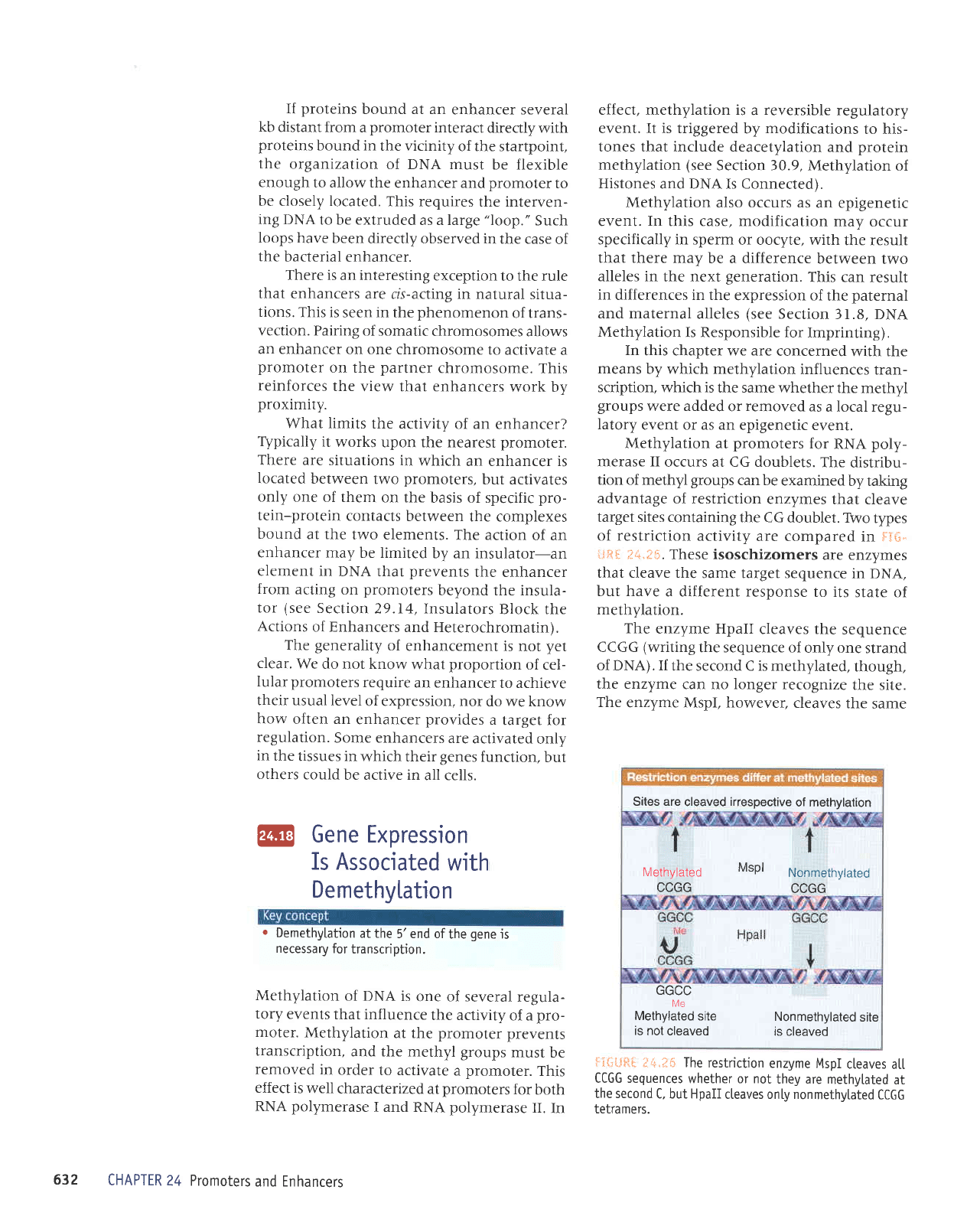
If
proteins
bound at an
enhancer several
kb
distant from
a
promoter
interact
directly with
proteins
bound in
the vicinity
of the startpoint,
the
organization
of DNA
must be flexible
enough
to allow the
enhancer and
promoter
to
be closely located.
This requires
the interven-
ing DNA
to be extruded
as a large
"loop."
Such
loops
have been
directly observed
in the case
of
the
bacterial
enhancer.
There is
an interesting
exception
to the rule
that
enhancers
are cli-acting in natural
situa-
tions.
This is
seen in the
phenomenon
of trans-
vection. Pairing
of somatic
chromosomes
allows
an enhancer
on one chromosome
to
activate a
promoter
on the
partner
chromosome.
This
reinforces
the
view that enhancers
work
by
proximity.
What limits
the activity
of an
enhancer?
\pically
it works
upon the nearest
promoter.
There
are situations in
which
an enhancer is
located
between
two
promoters,
but activates
only
one of them
on the
basis of specific
pro-
tein-protein
contacts
between
the complexes
bound
at the
two elements.
The action
of an
enhancer
may be limited
by an insulator-an
element in
DNA that
prevents
the enhancer
from
acting
on
promoters
beyond the insula-
tor
(see
Section
29.I4, Insulators
Block the
Actions
of Enhancers
and Heterochromatin).
The
generality
of
enhancement
is not
yet
clear.
We
do not know
what
proportion
of
cel-
lular
promoters
require
an enhancer
to achieve
their usual
level
of expression, nor
do
we
know
how
often an
enhancer
provides
a
target for
regulation.
Some enhancers
are
activated
only
in
the
tissues in
which their
genes
function,
but
others
could
be active in
all cells.
l@
Gene Expression
Is Associated
with
Demethylation
e
Demethylation
at the
5'end of
the
gene
is
necessary
for
transcription.
Methylation
of
DNA
is
one of several
regula-
tory
events
that influence
the activity
of a
pro-
moter.
Methylation
at the
promoter
prevents
transcription,
and the methyl groups
must
be
removed
in
order
to activate
a
promoter.
This
effect is
well
characterized
at
promoters
for
both
RNA
polymerase
I and RNA polymerase
II.
In
effect, methylation is
a
reversible
regulatory
event. It is triggered
by
modifications
to his-
tones that include deacetylation
and
protein
methylation
(see
Section 30.9, Methylation
of
Histones
and DNA Is Connected).
Methylation
also occurs as
an epigenetic
event.
In
this case, modification
may
occur
specifically in sperm
or oocyte, with
the result
that there may
be a difference
between
two
alleles in
the next
generation.
This can result
in
differences in the
expression of
the
paternal
and maternal
alleles
(see
Section
31.8, DNA
Methylation
Is Responsible for
Imprinting).
In
this chapter we are
concerned
with the
means
by which methylation
influences
tran-
scription, which is
the same whether
the methyl
groups
were added
or
removed
as
a local regu-
latory
event or as an
epigenetic event.
Methylation
at
promoters
for
RNA
poly-
merase II
occurs at CG doublets.
The
distribu-
tion of methyl
groups
can be
examined
by taking
advantage
of restriction
enzymes
that cleave
target sites containing
the CG
doublet. TVvo
tlpes
of restriction
activity
are compared
in
ilt*-
iiRil li4.F*s.
These isoschizorners
are enzymes
that cleave the
same target sequence
in DNA,
but have
a different response
to its
state of
methylation.
The
enzyme HpaII
cleaves the
sequence
CCGG
(writing
the sequence of
only one
strand
of DNA). If
the second C is methylated,
though,
the enzyme
can no longer
recognize
the site.
The
enzyme MspI, however,
cleaves
the
same
fi{;ii*t-
Jri
.;:$
The
restriction
enzyme
MspI
cteaves
at[
CCGG sequences
whether or not
they are
methytated
at
the second
C. but HpaII
cteaves only nonmethytated
CCGG
tetramers.
Sites are
cleaved
irrespective
of methvlation
N/ethyiated
MsPl
Nonmethylated
CCGG
CCGG
UUUU
lvle
Methylated
site
Nonmethylated
site
is not
cleaved
is
cleaved
632
CHAPTER
24 Promoters
and Enhancers
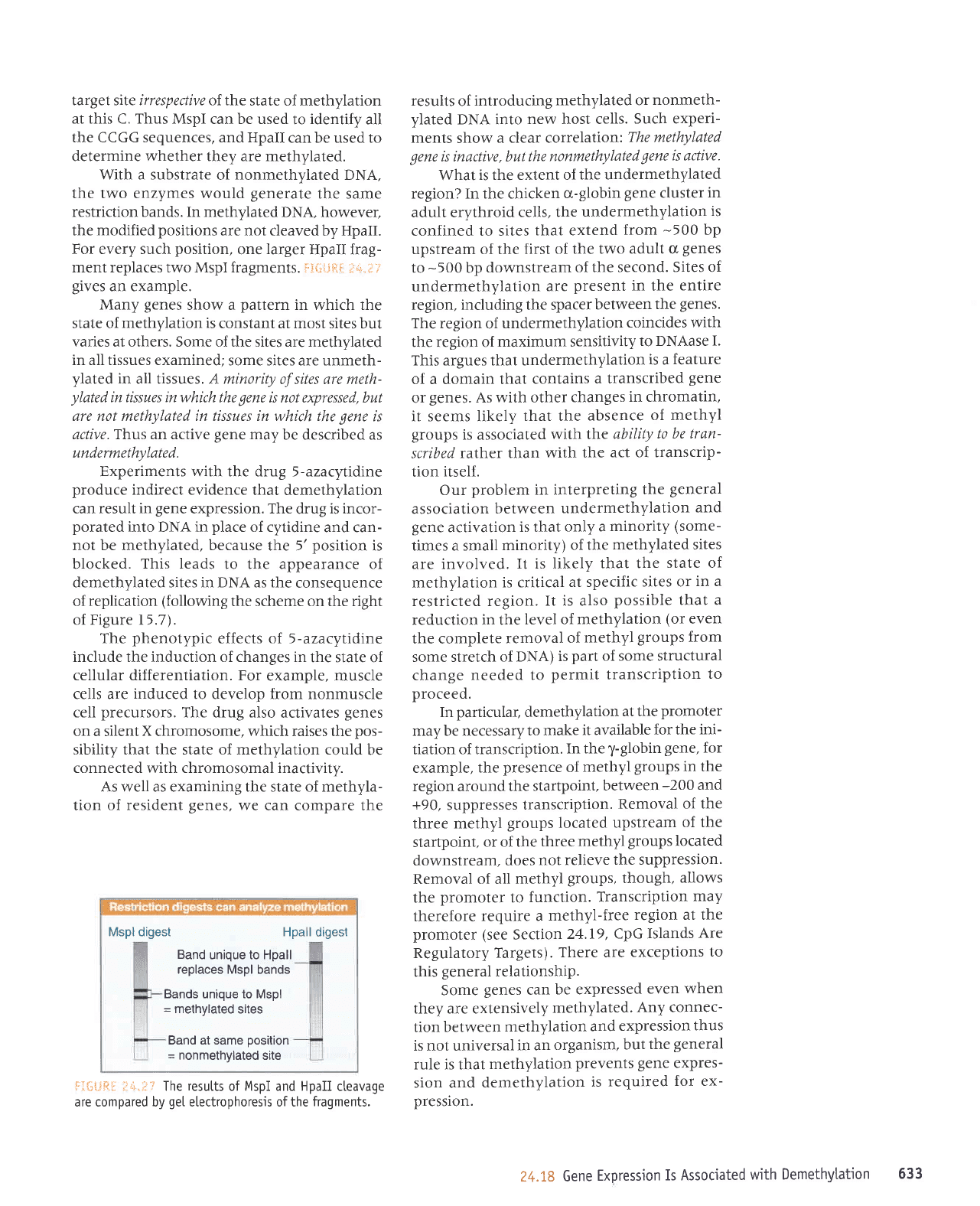
target site irrespective of the
state of methylation
at this C. Thus MspI
can be used
to
identify
all
the CCGG sequences, and HpaII
can be used to
determine whether they are methylated.
With a substrate
of
nonmethylated
DNA,
the two enzymes would
generate
the same
restriction bands. In methylated
DNA, however,
the
modified
positions
are not cleaved
by
HpaIL
For every such
position,
one
larger
HpaII frag-
ment replaces two MspI fragments.
fI*iift{ :il+"i{';
gives
an example.
Many
genes
show a
pattern
in which the
state of
methylation is
constant at most sites
but
varies at others. Some of the sites are methylated
in all tissues examined;
some sites are unmeth-
ylated
in all tissues . A minority
of sites are meth-
ylated
in tissues in which
the
gene
is not expressed, but
are nlt methylated in tissues in which the
gene
is
active. Thus an active
gene
may
be described as
undermethylated.
Experiments with the drug 5-azacytidine
produce
indirect evidence
that demethylation
can result
in
gene
expression. The
drug
is incor-
porated
into DNA in
place
of cytidine
and can-
not be methylated, because
the 5'position is
blocked.
This leads
to the appearance of
demethylated sites in DNA as the
consequence
of
replication
(following
the scheme on the right
of
Figure I5.7).
The
phenotypic
effects of 5-azacytidine
include the induction of changes in
the state of
cellular differentiation. For
example, muscle
cells are
induced
to develop from nonmuscle
cell
precursors.
The drug also
activates
genes
on a silent
X
chromosome, which raises the
pos-
sibility that the state of methylation could
be
connected with chromosomal inactivity.
As well as examining the state of methyla-
tion
of resident
genes,
we can compare the
Mspl digest Hpall
digest
Band
unique to Hpall
replaces Mspl bands
Bands unique to Mspl
=
methvlated
sites
Band at same
oosition
=
nonmethylated site
fIfii-lF.g
ii4.t? The
resutts
of MspI and HpaII cteavage
are compared by
gel
etectrophoresis of the
fragments.
results
of
introducing
methylated or
nonmeth-
ylated
DNA into
new host cells.
Such experi-
ments
show
a clear correlation;
The methylated
gene
is inactive, but the
nonmethylated
gene
is
active.
What
is the extent of
the undermethylated
region? In the chicken
a-globin
gene
cluster
in
adult erythroid
cells, the
undermethylation
is
confined to sites
that extend
from
-500
bp
upstream of the
first of the two
adult cr
genes
to
-500
bp
downstream
of the second.
Sites of
undermethylation
are
present
in the
entire
region, including the spacer
between
the
genes.
The region
of
undermethylation
coincides with
the region of
maximum sensitivity
to DNAase
I.
This argues that undermethylation
is a
feature
of a domain that
contains
a transcribed
gene
or
genes.
As
with
other
changes
in chromatin,
it seems likely
that the
absence
of methyl
groups
is associated
with the
ability
to be tran-
scribed
rather than
with the
act of transcrip-
tion
itself.
Our
problem
in interpreting
the
general
association
between
undermethylation
and
gene
activation
is that
only a
minority
(some-
times a small
minority) of
the
methylated sites
are involved.
It is likely
that the
state of
methylation
is critical
at specific
sites or
in a
restricted region.
It is also
possible
that a
reduction in the
level of
methylation
(or
even
the complete
removal
of
methyl
groups
from
some stretch
of DNA)
is
part
of some structural
change
needed to
permit
transcription
to
proceed.
In
particular,
demethylation
at the
promoter
may be necessary
to make
it available
for the
ini-
tiation
of transcription.
In the
y-globin gene,
for
example,
the
presence
of
methyl
groups
in the
region around the
startpoint.
between
-200
and
+90,
suppresses
transcription.
Removal
of the
three methyl
groups located upstream
of the
startpoint,
or of the
three
methyl
groups
located
downstream,
does
not relieve
the suppression.
Removal of all
methyl
groups, though,
allows
the
promoter
to
function.
Transcription
may
therefore
require a
methyl-free
region at the
promoter
(see
Section
24.I9,
CpG Islands
Are
Regulatory Targets).
There are
exceptions
to
th
is
general
relationship.
Some
genes
can
be expressed
even
when
they are extensively
methylated.
Any connec-
tion
between
methylation
and
expression
thus
is not universal
in an
organism,
but
the
general
rule is that
methylation
prevents
gene
expres-
sion and
demethylation
is
required
for ex-
pression.
24.1,8 Gene
Expression
Is Associated
with Demethytation
633
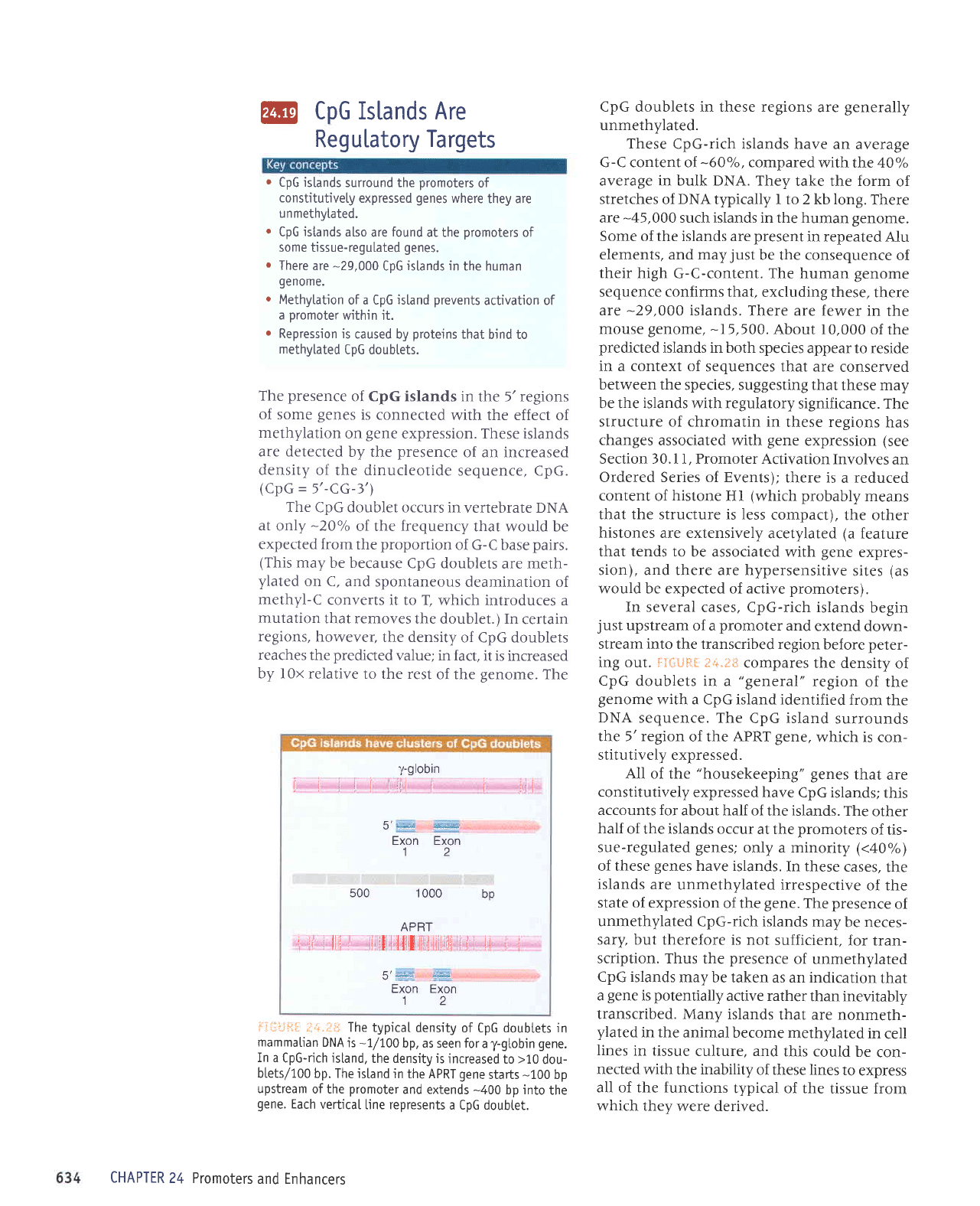
l@
CpG Islands Are
Regulatory
Targets
.
CpG islands
surround the
promoters
of
constitutivety
expressed
genes
where
they are
un methytated.
.
CpG
istands
also
are
found
at the
promoters
of
some tissue-regulated
genes,
r
There
are
-29,000
CpG
is[ands in
the human
gen0me.
o
Methytatjon
of a CpG
istand
prevents
activation of
a
promoter
within it.
o
Repression is
caused by
proteins
that
bind to
methylated
CpG doubtets.
The presence
of CpG islands in
the 5'regions
of some
genes
is connected
with the effect
of
methylation
on
gene
expression. These
islands
are detected
by the
presence
of an increased
density
of the dinucleotide
sequence, CpG.
(CpG
=
5'-CG-3'l
The
CpG doublet occurs in
vertebrate DNA
at
only
-20oh
of the
frequency
that would be
expected from
the
proportion
of G-C base
pairs.
(This
may
be because
CpG doublets
are meth-
ylated
on C,
and spontaneous
deamination of
methyl-C
converts it to T,
which introduces a
mutation
that removes
the doublet.) In
certain
regions,
however,
the density
of CpG doublets
reaches
the
predicted
value;
in fact,
it is increased
by l0x relative
to the rest
of the
genome.
The
y-globin
lritiltlil]il
5'**&d
ffi
Exon Exon
12
500 1000
bp
APRT
5'r*-y
Exon Exon
12
i:i--*i
:i+..-:iJ
The
typicaI density
of CpG doubtets in
mammatian
DNA
is
-1/100
bp, as seen for
a
y-gtobin
gene.
In a
CpG-rich island,
the density is
increased
to
>10
dou-
btets/100
bp. The istand
jn
the APRT
gene
starts
-100
bp
upstream
of the
promoter
and extends
-400
bp into
the
gene.
Each
vertical
Line represents
a CpG doubtet.
CpG doublets in these regions
are
generally
unmethylated.
These
CpG-rich islands have
an average
G-C content of
-60"/",
compared
with the 40%
average in bulk DNA. They
take the form
of
stretches
of
DNA
typically I to 2 kb long.
There
are
-45,000
such islands in the human genome.
Some of the islands are
present
in repeated
Alu
elements, and may
just
be the consequence
of
their high
G-C-content. The human
genome
sequence confirms that,
excluding these,
there
are
-29,000
islands.
There are
fewer in
the
mouse
genome,
-15,500.
About 10,000
of the
predicted
islands in both
species appear
to
reside
in a context of
sequences that are
conserved
between the
species, suggesting that
these may
be the
islands
with regulatory
significance. The
structure of chromatin in
these regions
has
changes
associated with
gene
expression
(see
Section 30.1 I, Promoter Activation
Involves
an
Ordered Series of Events);
there is
a reduced
content
of
histone
Hi
(which
probably
means
that the structure is less
compact),
the other
histones
are extensively
acetylated
(a
feature
that tends to
be associated with
gene
expres-
sion), and there are hypersensitive
sites
(as
would be expected of active
promoters).
In several
cases. CpG-rich islands
begin
just
upstream
of a
promoter
and
extend
down-
stream into the transcribed region
before
peter-
ing out. I?iltitiil ;lri.#*i
compares
the density
of
CpG
doublets in a
"general"
region
of the
genome
with a CpG island identified
from
the
DNA
sequence. The
CpG island
surrounds
the 5'region
of the APRT
gene.
which is
con-
stitutively expressed.
All of the
"housekeeping"
genes
that
are
constitutively
expressed have
CpG islands;
this
accounts for
about half of
the
islands.
The
other
half
of the islands occur
at the
promoters
of
tis-
sue-regulated
genes;
only a minority (<40%)
of these
genes
have islands.
In these
cases,
the
islands are
unmethylated irrespective
of the
state of expression
of the
gene.
The
presence
of
unmethylated
CpG-rich islands
may
be neces-
sary, but
therefore is not
sufficient,
for tran-
scription. Thus
the
presence
of unmethylated
CpG islands
may
be taken as an indication
that
a
gene
is
potentially
active rather
than inevitably
transcribed. Many
islands
that are
nonmeth-
ylated
in the
animal become
methylated
in
cell
lines
in tissue
culture, and
this could
be
con-
nected
with the inability
of these lines
to
express
all of the functions
typical of the
tissue from
which they
were derived.
CHAPTER
24 Promoters
and Enhancers
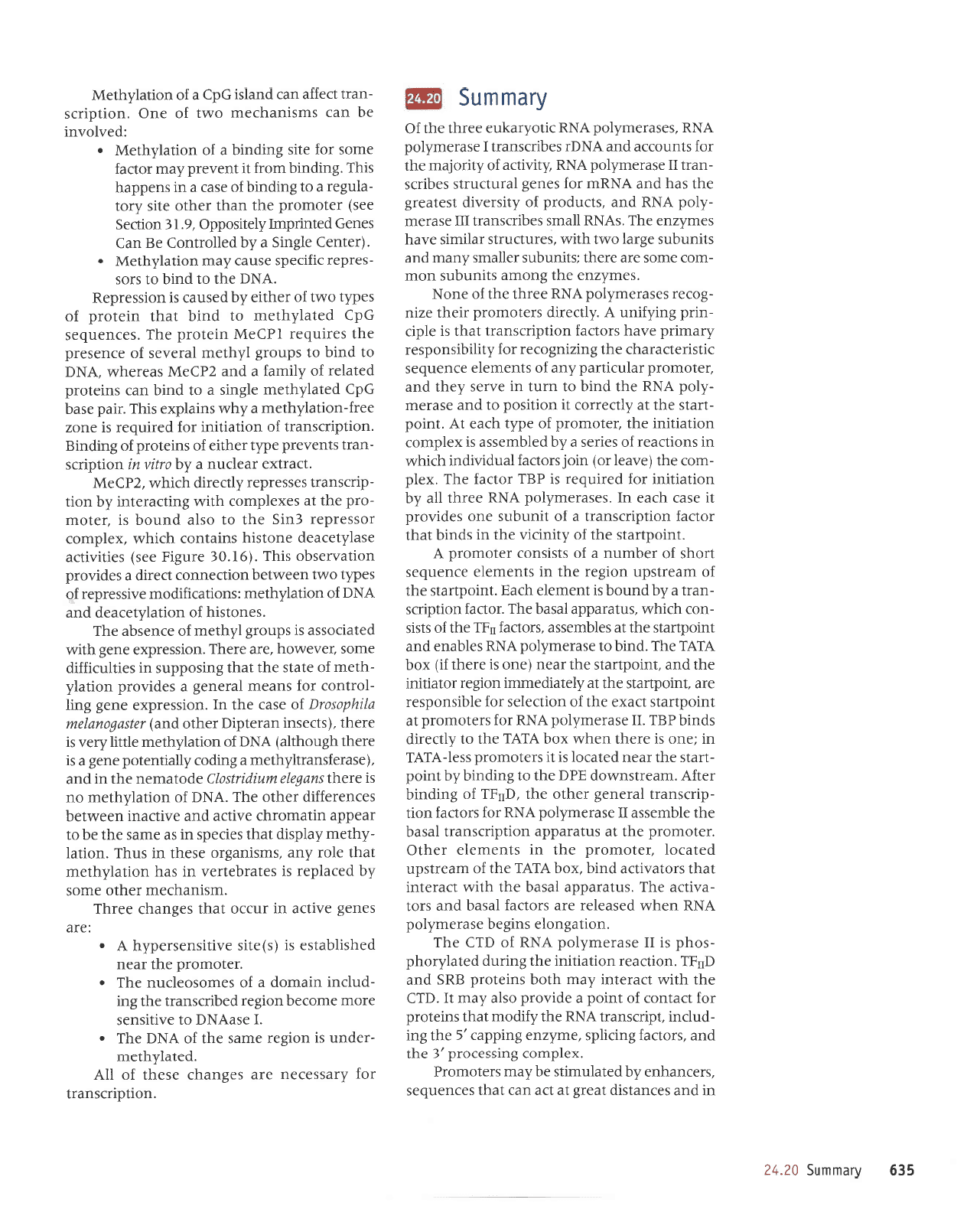
9€9
^rPuruns
oz'tz
uI
pue
saJuelsrp
leeJ8
lp lJe
uef,
leql
sJluJnbas
'sJJrupqua,{.q
palepruqs
aq
Aeru sJJtoruoJd
'xaldruol
Surssarord,g
aql
pue
'sJoDeJ
Sunrlds
'aru.{zua
Surdder,E
aqt 3u1
-pnpur
'ldrnsuerl
yNU
aq1 zlrpou
teqt
surato.rd
JoJ
tJetuo)
yo
rulod
e apr.lord osle
,leru
tI
'qI)
eqr
qll^\
tJelalur
Leru qtoq
suralord
gus pue
(II{J
'uorpeal
uortertrur aql Surrnp
patel[roqd
-soqd
sr
11
aseraru^d1od
VNU
Jo
(IJ) rqJ
'uorle8uola
sut3 aq aserarul.lod
vNu
uJqM
pesealJr
JJe sJol)eJ
Ieseq
puP
srol
-PArtJe
aqJ
'snlBredde
leseq
Jql
qlrM
lJeJJluI
leql
srolenrlJe
purq
'xoq
yJVJ
aql;o
ruearlsdn
pJlelol
'raloruord
eql ur sluauJlJ
JJqIO
'.ralouord
eql
le
snleJedde uortdrnsupJl
Ipspq
aql alqruJssp
l
ase;aru,{.1od
ypg
ro; sJotJpJ
uoll
-drnsue.rt
praua8
raqlo eql
'(IISJ
Jo
Sutputq
ra{V
'ueerlsuMop
[dq
aql o1 Surpurq,{q
lurod
-uets
aql reJu
pelplol
sr
lr
srJlourord ssal-y1y1
ur lJuo
sr aJeql uer{M xoq
yJvJ
Jql ot
{ltrertp
spulq
dgI
'1
aseraurllod
VXU
ro; sraloruord
1e
lurodlrels 1lpxa
Jql
Jo
uorpeles:o; alqrsuodsar
are
'luroduels
aq1
le.dlaterpJrrrur
uor8ar JoteBrul
eqt
pup
'tuloduets
eq1 reau
(auo
sr araqr
y) xoq
VJVI
aqJ'purq 01 aserauLlod
yNU
selqeue
pup
turoduets
Jql
te
sJlqruJsse
'sJopeJ
tr91
aql;o ststs
-uoJ
qJrqu
'snleredde
pseq
JqJ
'rope;
uorldrr;s
-uert
e iq
punoq
sl
luJrrrJle
qreg
'turoduets
aq1
;o
ruearlsdn uor8ar Jql ur slueuJlJ J)uanbes
lJoqs
Jo
JJqunu
p
Jo
stsrsuo) ralouo.rd
y
'turodtrets
aqt
;o
,ltruorl
aqt
ur spulq
teql
roDeJ
uorldrJ)suPJl P
Jo
lrunqns
auo
sapr,rord
1l
aseJ
qJeJ
uI
'saserarudlod
y111g
aarql
p ,{.q
uorleruur
ro;
pa:rnbar
sl
dgJ:one;
aq1
'xa1d
-ruoJ
Jql
(a,lea1
ro)
urol sroDey
lenprnrpul
qJIqM
ur suorpeal
Jo
sarJes e
,{.q
palqruasse
sr
x:ldruor
uortertrur Jqt ieloruord
yo
addl
qrea
ty
'turod
-upls
Jqt
te
,{lDauor
11
uorllsod ot
pup
esprJru
-ui1od
y51g
Jql
purq
01 urnt ur anres
,(aqt
pue
talourord
relnrrued,{.ue
Jo
slueuJla
aruanbas
JrlSrJJlJPrPqr aql SurzruS0JeJ JoJ .{.lrlrqrsuOdSar
.{rerurrd JApq sJolf,eJ uorldrnsuerr
leqt
sr aldtr
-urrd
Surzfrun
y
'^dprarrp
sratourord
Jraqt
JZIU
-3orar
saseraurLlod
VNU
eJrql aql
Jo
JuoN
'saruLzua
aql Suorue
slrunqns
uotu
-uroJ
euros eJe eJerll
lslrunqns
rJlletus
dueu
pue
slrunqns a8rel o.nt1
qlrm
'sJJnlJnJls
rel[urs
eleq
saru.{.zua JqJ'sVNU
Ilprus
seqrrJsuen
ilI
JSeJaLu
-d1od
ygg
pue
'spnpord
yo
,hrsraalp
tsatear8
eql seq
pue
VNUIU
ro; saua8
lernlf,nJts
seqlr)s
-upn
11
aserau.dlod
y51g
Llr,rrpe
1o
,htroferu aql
JoJ slunoJf,p
pup
VN(r
seqrJJsu€Jt
I
aserarudlod
vNu
'sJseJeu,{1od
ygg
r1lor{re>1na
JJrqt Jqt
JO
'uorldrnsuerl
rol
dressarau arB saBuBr{J
JSJqI
Jo IIv
'petelAqletu
-Jepun
sr
uor8ar aues
eql
Jo
VN11
aI{J
.
'I
asPYN(
01 aAIlISuJs
aroru
euroJaq
uo6ar
peqIJJSueJl
aq1 3ur
-pnlJul
uleulop
e
Jo
sauosoJlf,nu
el{l o
'raloruord
aql
reeu
peqsrlqetse sr
(s)a11s
a,rrttsuasradtrq
V
.
:AJP
saua8
alrlre ur rnJJo
1eql
sa8ueqJ
JJrqJ
'ursrueqJeru
raqlo Jrxos
z(q
pareldar
sr sJleJqauJn
uI seq
uorlelLqlaur
teql
aloJ
z(ue
'srustue8ro
asaql ut snqJ
'uoIlPI
-dqrau
r(eldsrp
teql
sanads uI
se arues eql aq 01
readde ulteruoJqr
eAIlJe
pue
enlppq uaemlaq
seJuaraJJrp
Jeqlo eq1,
'vN11
Jo
uolle1[qlaur
ou
st antlt suaCap
wnrywsll)
apolpuau eqt
uI
pue
'(aseraysuerllz(qtaru
e Surpor
[1equa1od aua8 e sr
araqt
q8noqtp)
VNO
Jo
uorlelz(q1aru aplu
fua,r st
araql'(sDasut
ueraldr( raqto
pue)
n4sudoualaw
apqdosotq
Jo
ase) eq1
q'uorssardxa
aua8 3u11
-loJluoJ
JoJ sueelu
praua8
e sapnord
uone1,{
-qlau
Jo
e1els eqr
ipqt
Sutsoddns
uI sJIllnJIJJIp
Jruos'JeAeMoq'eJE
araqJ'uolsserdxa
aua8
qlu,t
peterlossp
s1 sdnor8
1,{qraur Jo
eJuasqe
eqJ
'seuolslq
;o
uorlelzfuateJp
pue
VN11
Jo
uoqe1,{qlaru
:suolleJlJlpour arrrssardar
yo
sad.r{l o,ut
uJJMleq uollJauuo)
IJJJIp
e sapnord
uorlpnJesqo
sIqJ
'(9I'0€
arn8tg
aas) satlr,ulre
aselLlareap
auolsrq
suletuoJ
qJIqrvr
'x:ldruor
rossardar
€uIS
Jq1 ot osle
punoq
sI
'Jeloru
-ord
aqt
1e
saxaldruoJ
qlIM
Surtreralut
^q
uoll
-drnsue;l
sassardar,{lrrartp
q)lqm'Zd)aW
'lJerlxe
JealJnu
e
f,qo4ttt zz uotldrns
-ueJt
stuJleJd adrh
raqtra;o
sutalord;o Surpurg
'uorldrnsueJl
Jo
uollelllul
roy
partnbeJ
sI euoz
aar;-uoqeldqlaru
e
dq,u. sureldxa
stql'rted aseq
9d3
palelLqlaur a13uts e 01
pulq
uer suralord
pJtpler;o Lpue;
p
pup
Zd)eW
seaJJqM
'VN(
01
pqq
o1 sdnor8
1,{qlaru IerJAas
;o
aruasard
aql sartnbal
Id)aw
utalord
aq1
'saruanbas
9d3
patelz(qlau
ot
pulq
teql
utalord
;o
saddt
oazll
]o
JeqlIJ
z(q
pasner
sr uotssardag
'vN(
aql
ol
pulq
ol sros
-sa,rda.r
rqnads
asnel
.{eru uor1e1,{.q1ayn
.
'(rarua)
apurg
e ,{.q
pallonuo)
ag
ue)
sJuag
prlrruduq Llaltsodd
O
'
6' I€
uoIDeS
aas) raloruord
aqr
upl{l Jaqlo
alrs
zhol
-eln8ar
e ot Surpurq
yo
JseJ e ut
suaddeq
srql
'Surpurq
IUoJJ
1l lua,rard
^eru
ropeJ
Jruos
JoJ alrs
Sutputq
e
;o
uor1e1,{.qlaw
.
Jq uer
sursrueqJJur
-uPI
DaJJe
ueJ
puelsl
:paAIoAur
o&rl
Jo
aug
'uorldurs
9d3
e
yo
uor1e1.dqlayq
&eu un5
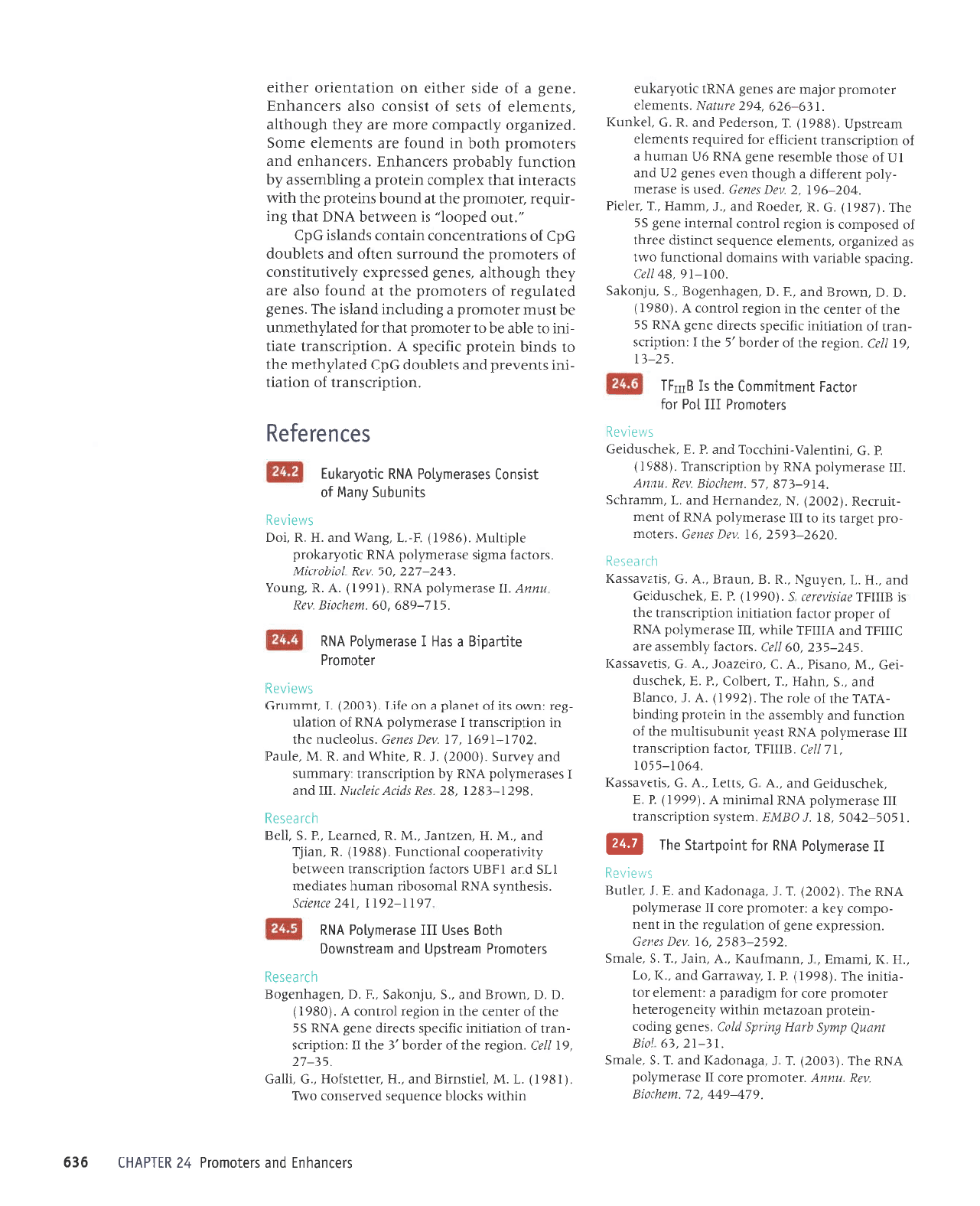
'6L1-6VV
'ZL'Luarp)tg
'Aaa
nuuv'Jalouord
aroJ
II
JselJu^lod
VNU
aqJ'(SOOZ)
'1
1'e8euope>I
pup'J'S
'aletus
'rc-IZ'€.9
l0!S
ryanj
dwtg qtog
Cuttdg plo1
saua8 Surpor
-uralord
ueozBtetu
urqtrM,{1raua3orelaq
raloruord
JJo) roJ
ru8rpered
e
:luJtuJle
rol
-elllur
eql'(eOOt)
7'1
Le.trerreg pup
">I'o'I
"H
>J
'rurprull
'f 'uupurJne>I
''v 'ulpf
''I
s
'alplus
'
z6EZ-€g EZ'
g
I'^aQ
saua
g
'uorssaldxa
auaS yo
uorleln8ar
Jq1 ur
tuau
-oduror
Ao>1
e
:raloruord
a-ror
11
aserauLlod
vNU
aqJ
'\ZOOZ)
I'1
'eSeuope)
pup
'A
f
rrllng
sM0rAau
11
ase.raru[106
VNU
roJ
turodile]S
eql
@
'
1SjS-zvOs'gI'l
Oswg'uals,{s
uortdursuerl
111
eseraru,,ilod
VNU
Ieurrurru
y
'(666I
) a
'E
'>leqrsnpra9
pup
"v
D
'stta-I ''v
'D 'slrr^psse>I
'r90I-E
g0
r
'1
L
ilD
'SIII{J 'ro1re;
uorldr,rrsuerl
11
asereru,(1od
VNU
tsee.{
lrunqnsrtlnru
rr{l
Jo
uorlJunJ
pue,,{.lqruasse
aql ur
uralord Surpurq
-VIV1
rql
Io
rlor
rqJ
'(ZOO
t
)
'V 'f 'o)uplg
pue
''s 'ur{PH
''J'uaqlo)
'a'E'{eq)snp
-laD
"I^I
'ouesrd
''v') 'orrezeof
''v
c
,srla^psse>I
';yZ-SEZ
'09
1D'slolrpJ
,{lquasse
a.re
)I[{I
pue
VIIIJI
allqM
'y11
ase.rauLlod
VNU
yo
radord
JolJpJ
uorlprlrur
uorldrnsue:1
aq1
sl
SIII{I
aotst^aril
S'(066I)
7'g'>laqrsnprag
pup
'H '1 'uo,{.n8g
''U 'g 'unprg
"V
'g 'srtplesse)I
qr.r
easau
'
07gz-t6Ez'
g
I'^aQ
sauat
.
sra}olJJ
-ord
la8ret
str or
III
aseraurdlod
VNU
Jo
tueru
-Unrrrg'(ZO0Z.)
N'zepueureH
pup'-I,luruprllrs
'rI6-€Lg
'LE'wau)7tg '^aa
'nuuv
'11
aseraruLlod
VNU
.{q uorldrnsuprl
'(gg6
I
)
a
'D
'rurlurlp^-rurq)JoJ
pue
a
'a
,>leqJsnpraD
sralourord
III
l0d
r0J
lollPl
luaulruur0l
aql sI
gIIIll
'te-€I
'6I
UD'uor8ar
rqt
Jo
lrptoq,g
ael
I
:uorldr.rls
-uerl
Jo
uortprlrui
rr;oads
slrelp
aua8
VNU
SE
aqt
Jo
rrtua)
aql ur
uor8a:
Iortuor
V
'(096
I )
'61 '(
'umorg
pup
'J
'q 'ua8equaSog
,.9
,n[uo1eg
'00I-I6 ',8t
ila)
'Suoeds
elqprrpl qtrM
surpuop
IpuorlJunJ
oM1
se
pezrue8ro
'slueruJla
aluanbes
lJurtsrp
aeJql
;o
pasoduror
sr uor8a;
Iorluo) Ipuralur
aua8
5E
eqJ'(/86I)
D'U
reprog
pup
''f 'rurupH,.I
,relrrd
'r0z-g6I'z'^ao
sauag'prsn
sr aseraur
-d1od
rueralyp
e
q8noqt
ueaa sauaS
Zn
pup
l
n
Jo
Jsoqt JlqurrsJl
oua8
yyg
9n
upurnq
p
;o
uorldrnsuerl
luelJTJJJ
ro;
parrnbar
slueruela
ruearlsdn'(SSAt)'J'uosreped
pue
.U.g,le{un>I
'I€g-gzg
'16z
atw0N
.stuauala
ralourord
rofeur
are saueE
yggl
rr1o.r(re1na
sMarAau
slalueq ul
pue
slalouord
urqlrM spolq aruanbas
pJArasuoJ
oAAl
'(t
so t )
''I 'ht 'larrsurrg
pup
''H
lauersJoH
''D 'IIIpD
'sf-L7
'6I
ilD
'uor8ar
eqt
Jo
rJproq
,€
aqt
il
:uorldrrls
-uprt
Jo
uorterlrur rr;nads
slrarrp auaE
VNU Sg
eql
Jo
raluar
aql ur uor8ar
Iortuor
v
'
(
086 I
)
'O
C
'umorg
pup
'
S
'n[uo1e5
"4
'q 'ua8equaSog
sleJourold
uearlson
pue
ueallsuMo0
qlog
sasn
III
asPleu^lod
vNU
L6II-26I1'M
iluaDS
'stsaqluLs
VNU
lpruosoqrr
uprunq
selprpeur
I'IS
pup
I{gn
srolrpJ uortdr:rsuert
ueeMtaq
,{Ualteredoor
IpuortJunC
'(gge
t
)
'U 'uplh
pue
'w 'H
'uazluef
"w
'u
'peurPeT 'a 's 'llrg
qlr
Pasau
'
8 6Z l-f,8e t'
8Z'satr
spnv )Dpn
N' lll
pue
1
saseraru,ilod
VNU
Iq
uorldursuerl
:z(reruruns
pue.,{aa:ng
'(OOOZ)
'f 'U 'ellq6
pue
'U 'W 'elnpd
'z0LI-|69I
'LI
'^aQ
srilrt
'snloapnu
rql
ur
uortdrnsuerl
1
aseraudlod
vNu
Jo
uorleln
-Ear
:uzlro
stl
Jo
taueld
p
uo eJrI'(€OOZ)
'I 'trurunrD
sMarAau
Jalourold
alttlPdrg
P sPH
I
aseleu^lod
VNU
'
s I L-689' 09'
Luar4z)tg'^aN
nuuv
'tI
aserau,{1od
yNU (
I
66
I
)
'v 'U '8uno;
'
€.r7.-
LZ7.'
05',^au
l7tq2Dtw
'srotrpJ
eur6rs aserarudlod
y]rJg
rrto^rp{ord
a1dr11nry'(ssot)
'g-'1
'8ue14
pue
'H
u
'loo
sMarAau
qrunqns
Aue6
;o
lsrsuoJ
saselau^lod
yyX
rLlo&e1n3
saluaJaJau
'uorldrJf,suerl
Jo
uorlell
-rur
stuanard
pup
stJlqnop
gd3
palelz{qlJru
Jql
ol spulq ulJlord
)IJItads
V
'uotldursueJl
Jlpll
-rur
ot JIqp aq ot ratoruord
teql
ro;
pate1,,{qtaruun
Jq
tsnur
JJloruoJd
e Surpnpur
puplsr
eqJ
'seuJ8
pa1e1n3ar
Jo
srelouord
aqr
te
punoJ
osle
JJe
[aqr
qSnoqlie'saua8
pJSSJJdxe
z{la,rrlnlrtsuor
Jo
srJlotuord
aqt
punouns
uJlJo
pue
slJlqnop
gd)
Jo
suortpJluaJuof,
ureluoJ
spuelsr
gd3
,,'1no
padool,,
sr uJeMleq
VNq1
ieqt
8ur
-rrnbar
latourord
Jr{l
le
punoq
surJloJd aq1
qtrM
st)eJalur
tpqt
xalduor
uratord e
Surtqruasse Lq
uorlJunJ ,{lqeqord
sJaJuequ1
'sreJuequa
pue
sJJlOruOJd qloq
ur
punoJ
JJp
slueualJ Jrxos
'pazrue8ro
,(preduror
eJoru ere .{aql qSnoqtle
'sluJruJla
Jo
slJS
Jo
lsrsuof,
oslp sJJJuequg
'aua8
e
Jo
aprs
reqllJ uo uorleluarJo
JJqlrJ
rz
utldvHl
9€9
q
lr e asau
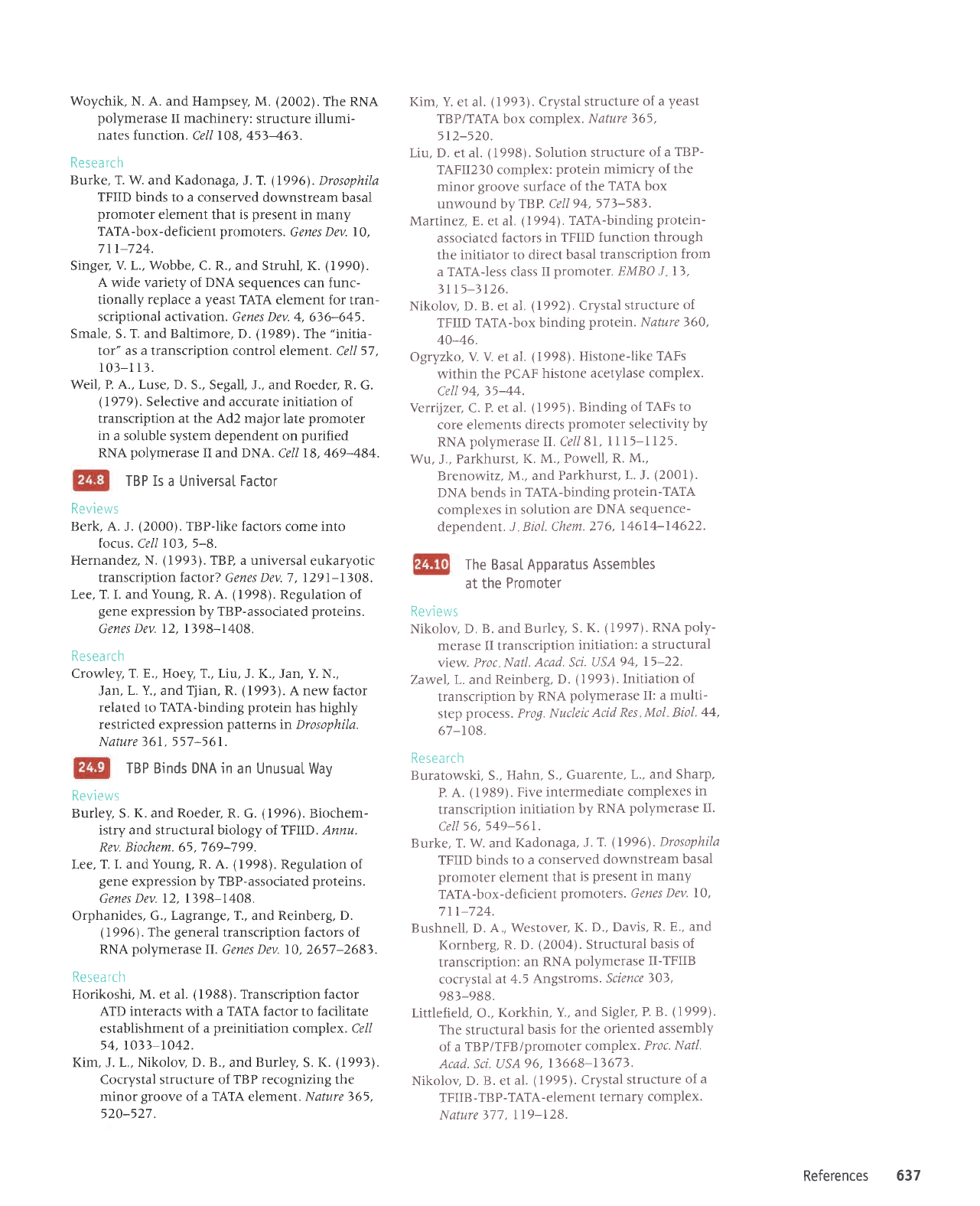
Woychik, N. A. and Hampsey, M.
(2002).
The RNA
polymerase
II machinery:
structure illumi-
nates function.
Cell
lO8,
453463.
Resea
rc
h
Burke, T.
W. and
I(adonaga,
J. T.
(1996).
Drosophila
TFIID binds to a conserved
downstream basal
promoter
element
that
is
present
in many
TATA-box-deficient
promoterc.
Genes
Dev. lO,
7 lt-724.
Singer,
V.
L., Wobbe,
C.
R.,
and Struhl, K.
(1990).
A
wide variety of
DNA
sequences can func-
tionally
replace
a
yeast
TATA element for
tran-
scriptional activation. Genes Dev.
4, 636-645.
Smale, S.
T. and Baltimore, D.
(1989).
The
"initia-
tor" as a transcription control element.
Cell
57,
I
0t-l
I
3.
Weil,
P. A., Luse,
D. S., Segall, J., and Roeder, R.
G.
(\9791.
Selective and accurate initiation
of
transcription at the Ad2 major
late
promoter
in
a soluble system dependent on
purified
RNA
polymerase
II and DNA.
Cel/
18, 469-484.
TBP Is
a Universal
Factor
Reviews
Berk, A.
J.
(2000).
TBP-like factors
come into
focus.
Cell
103,
5-8.
Hernandez, N.
(1993).
TBP, a universal
eukaryotic
transcription factor?
Genes
Dev. 7
,
l29l-ll}8.
Lee, T. I. and Young, R. A.
(
I 998). Regulation
of
gene
expression by TBP-associated
proteins.
Genes
Dev. 12, li98-1408.
Resea
rch
Crowley,
T. E., Hoey, T.,
Liu, J. I(., Jan, Y.
N.,
Jan,
L. Y.,
and
Tjian,
R.
(1993).
A new factor
related
to
TATA-binding protein
has highly
restricted expression
patterns
rn Drosophila-
Nature
361, 557-561.
TBP Binds DNA in
an Unusual Wav
KCVICWS
Burley, S. K. and
Roeder,
R. G.
(1996).
Biochem-
istry and structural biology oITFIID. Annu.
Rev. Biochem. 6,
,
7 69-7 99 .
Lee,
T. I.
and
Young, R. A.
(1998).
Regulation of
gene
expression by TBP-associated
proteins.
Genes
Dev. 12, l)98-1408.
Orphanides, G.,
Lagrange, T.,
and
Reinberg, D.
(
I 996). The
general
transcription factors of
RNA
polymerasell.
Genes
Dev. 10,2657-268J.
Resea rc h
Horikoshi, M. et al.
(
I 988). Transcription factor
ATD interacts with a TATA factor
to
facilitate
establishment
of a
preinitiation
complex. Cel/
54,
rolJ-t042.
Ifim, J. L,, Nikolov
D. B.,
and
Burley,
S.
K.
(I99rl.
Cocrystal structure of
TBP recognizing
the
minor
groove
of a
TATA
element Nature
365,
520-527.
ICm, Y.
et al.
(t
993
).
Crystal structure
of a
yeast
TBP/TATA
box
complex. Nature
365,
5t2-520.
Liu, D. et al.
(1998).
Solution
structure
oI a
TBP-
TAFII230 complex:
protein mimicry of the
minor
groove
surface
of the
TATA box
unwound by
TBP. Cell 94,
57 3-583.
Martinez, E. et al.
(1994).
TATA-binding
protein-
associated
factors in
TFIID function
through
the initiator to
direct basal
transcription
from
a TATA-less ciass
II
promoter. EMBO
J 13,
3),r5-3t26.
Nikolov
D. B. et al.
11992).
Crystal
structure
of
TFIID TATA-box
binding
protein.
Nature
)60,
40-46.
Ogryzko,
V. V. et al.
(1998). Histone-like
TAFs
within
the PCAF
histone
acetylase complex.
Cell
94,
j5-44.
Verrijzer, C.
P. et al.
(1995). Binding of
TAFs to
core elements
directs
promoter selectivity by
RNA
polymerasell. Cell8l,
I I
l5-l125.
Wu. J.,
Parkhurst.
I(. M., Powell,
R. M.,
Brenowitz, M., and
Parkhurst,
L. J.
(2001).
DNA bends in
TATA-binding
protein-TATA
complexes
in solution
are
DNA sequence-
dependent.
J Biol. Chem.
27 6,
14614-14622.
The BasaI Apparatus
Assembles
at the
Promoter
Reviews
Nikolov D.
B.
andBurley,
S.
K.
(1997).
RNApoly-
merase II transcription
initiation:
a structural
view.
Proc Natl.
Acad. Sci. USA94,
15-22.
Zawel,
L.
and
Reinberg.
D.
(l993).
Initiation
oI
transcription
by
RNA
polymerase II: a multi-
step
process.
Prog.
Nucleic
Acid Res
Mol Biol.
44,
67-t08.
Resea rc h
Buratowski, S.,
Hahn, S., Guarente,
L., and Sharp,
P. A.
(1989).
Five intermediate
complexes
in
transcription
initiation
by
RNA
polymerase II.
Cell 56.549-561.
Burke, T. W and
I(adonaga,
J.T.
\1996).
Drosophila
TFIID binds
to a conserved
downstream
basal
promoter
element
that
is
present in many
TATA-box-deficient
promoters. Genes
Dev. 10,
7 tt-724.
Bushnell, D. A, Westover,
K.
D., Davis,
R. E., and
I(ornberg, R.
D.
(2004).
Structural
basis
of
transcription:
an
RNA
polymerase II-TFIIB
cocrystal
at 4.5
Angstroms.
Science
jO),
983-988.
Littlefield, O.,
I(orkhin,
Y., and
Sigler,
P. B.
(I999).
The
structural
basis
for the oriented
assembly
of a
TBP/TFB/promoter
complex.
Proc. Natl.
Acad. Sci. USA
96,
l)668-l)67).
Nikolov
D. B. et
al.
(1995).
Crystal
structure
of
a
TFIIB
-TB
P-TATA-element
ternary
complex.
Nature )77,
ll9-128.
References
637
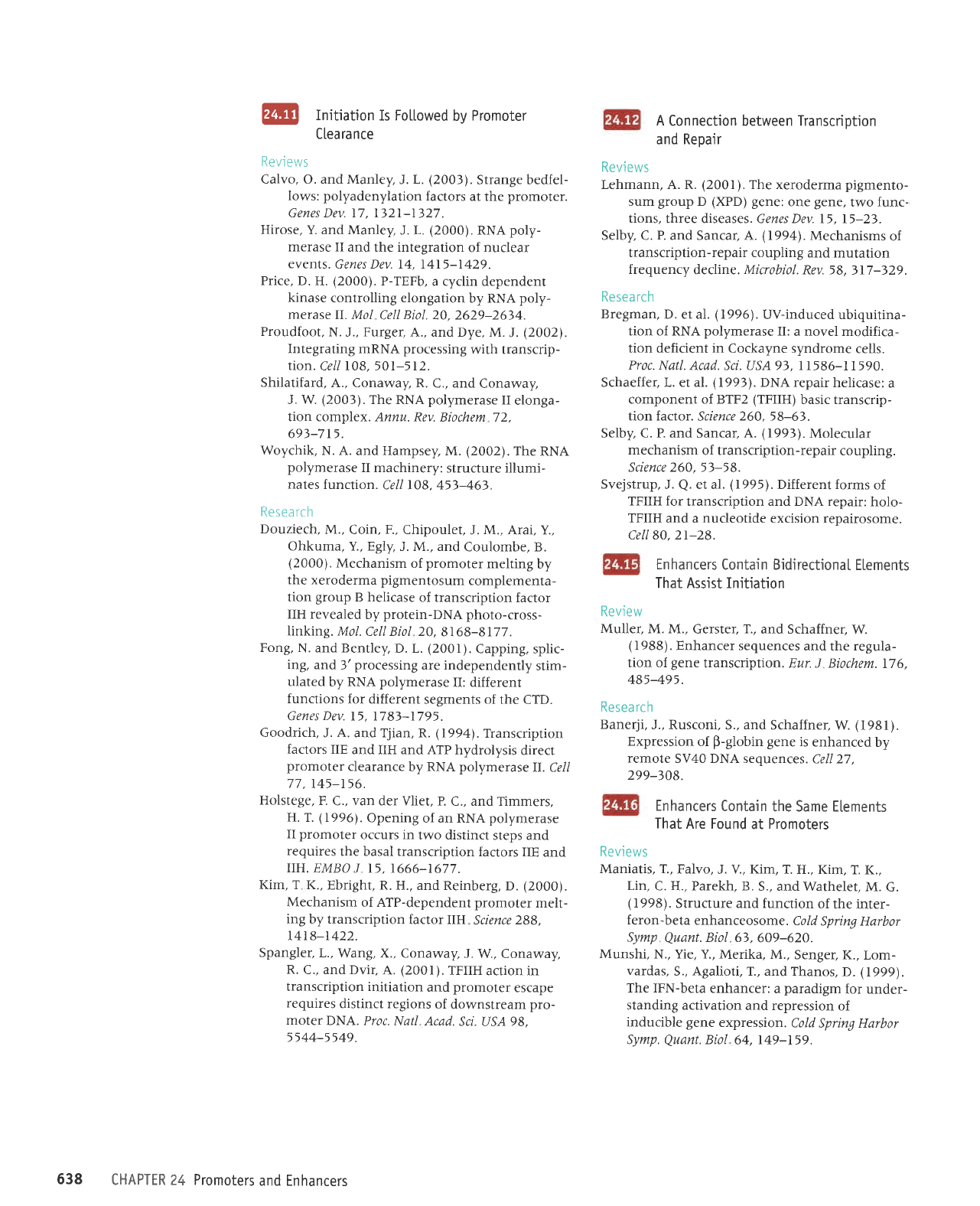
lB
Initiation
Is Fotlowed
by
Promoter
Clearance
Reviews
Calvo, O. and Manley,
J. L.
(2003).
Strange bedfel-
lows: polyadenylation
factors
at the
promoter.
Genes Dev. 17, l32l-l)27.
Hirose,
Y. and Manley,
J. L.
(2000).
RNA
poly-
merase II
and the integration
of nuclear
events.
Genes Dev.14, l4l5-1429.
Price,
D. H.
(2000).
P-TEFb,
a cyclin dependent
kinase
controlling elongation
by RNA
poly-
merase
lI. Mol
Cell
Biol.20,2629-284.
Proudfoot,
N. J.,
Furger,
A., and Dye, M.
J.
(2OO2l.
Integrating mRNA
processing
with transcrip-
tion.
Cell 108, 501-5 12.
Shilatifard,
A., Conaway, R.
C., and
Conaway,
J. W.
(2003).
The RNA
polymerase
II
elonga-
tion complex. Annu. Rev.
Biochem 72,
69)-7 15.
Woychik,
N. A.
and
Hampsey,
M.
(2002).
The RNA
polymerase
II machinery:
structure illumi-
nates
function.
Cell 108. 45j-463.
Resea rc h
Douziech,
M.,
Coin,
F.,
Chipoulet,
J.
M.,
Arai, Y.,
Ohkuma, Y.,Egly,
J. M., and
Coulombe, B.
(2000).
Mechanism
of
promoter
melting
by
the xeroderma pigmentosum
complementa-
tion
group
B helicase
of transcription
factor
IIH revealed
by
protein-DNA photo-cross-
linking. Mol.
Cell Biol 20,
8168-8177.
Fong,
N. and Bentley,
D. L.
(2001).
Capping,
splic-
ing,
and
3'processing are independently
stim-
ulated
by RNA
polymerase
II: different
functions
for different
segments of
the CTD.
Genes
Dev.
15, 178)-1795.
Goodrich,
J.
A.
and TJian, R.
(1994).
Transcription
factors IIE
and IIH and ATP
hydrolysis
direct
promoter
clearance
by
RNA polymerase
II. Cel/
77,
145-156.
Holstege,
F.
C., van der Vliet, P.
C., and Timmers,
H. T.
(1996).
Opening
of an RNA
polymerase
II
promoter
occurs in
two distinct
steps and
requires
the basal transcription
factors IIE
and
tIH.
EMBO J t5, 1666-1677.
I(m, T I(.,
Ebright, R.
H., and Reinberg,
D.
(2000).
Mechanism
of ATP-dependent promoter
melt-
ing
by transcription
factor IIH
Science 288,
t418-1422.
Spangler,
L.,
Wang, X.,
Conaway, J.
W., Conaway,
R.
C., and Dvir,
A.
(2001).
TFIIH
action in
transcription initiation
and
promoter
escape
requires
distinct regions
of downstream pro-
moter
DNA. Proc.
Natl Acad.
Sci-
USA
98,
5544-5549.
A
Connection between Transcriotion
and Repair
Reviews
Lehmann, A. R.
(2001).
The
xeroderma
pigmento-
sum
group
D
(XPD) gene:
one
gene,
two func-
tions,
three diseases. Genes Dev. 15,l5-2).
Selby, C.
P.
and Sancar, A.
(1994).
Mechanisms
of
transcription-repair coupling
and mutation
frequency
decline.
Microbiol.
Rev. 58,
)17-329.
Rese a rc h
Bregman,
D. et al.
(19961.
UV-induced ubiquitina-
tion of RNA
polymerase
II:
a novel modifica-
tion deficient in
Cockayne syndrome
cells.
Proc.
Natl. Acad. Sci. USA 9J, I 1586-1
1590.
Schaeffer, L. et al.
(19931.
DNA repair
helicase:
a
component of BTF2
(TFIIH)
basic transcrip-
tion factor.
Science
260,58-63.
Selby, C. P. and
Sancar,
A.
(1991).
Molecular
mechanism
of transcription-repair
coupling.
Science 260, 5j-58.
Svejstrup,
J.
Q.
et al.
(
I 995
).
Different forms
of
TFIIH for
transcription and DNA repair:
holo-
TFIIH
and a
nucleotide
excision reDairosome.
Cell 80,21-28.
Enhancers
Contain BidirectionaI
Etements
That Assist Initiation
Review
Muller, M. M.,
Gerster,
T.,
and Schaffner,
W.
(I988).
Enhancer sequences
and the regula-
tion of
gene
transcripion. Eur. J Biochem.
176,
485495.
Resea
rc h
Banerji,
J., Rusconi,
S.,
and
Schaffner,
W.
(1981).
Expression
of
B-globin
gene
is enhanced
by
remote
sv40 DNA sequences.
Cell 27,
299-)08.
Enhancers
Contain
the Same Elements
That
Are Found
at
Promoters
Reviews
Maniatis,
T., Falvo,
J.
V., I(im,
T. H., ICm,
T. I(.,
Lin,
C. H., Parekh, B.
S., and Wathelet,
M.
G.
(
I 998) .
Structure and function
of
the inter-
feron-beta
enhanceosome.
Cold
Spring Harbor
Symp
Quant.
Biol 63,
609-620.
Munshi,
N.,
Yie, Y.,
Merika, M.,
Senger, I(.,
Lom-
vardas,
S., Agalioti, T., and
Thanos, D. (1999).
The IFN-beta
enhancer:
a
paradigm
for under-
standing activation
and repression
of
inducible
gene
expression.
Cold
Spring Harbor
Symp.
Quant.
Biol
64,
149-159.
638
CHAPTER 24 Promoters
and Enhancers
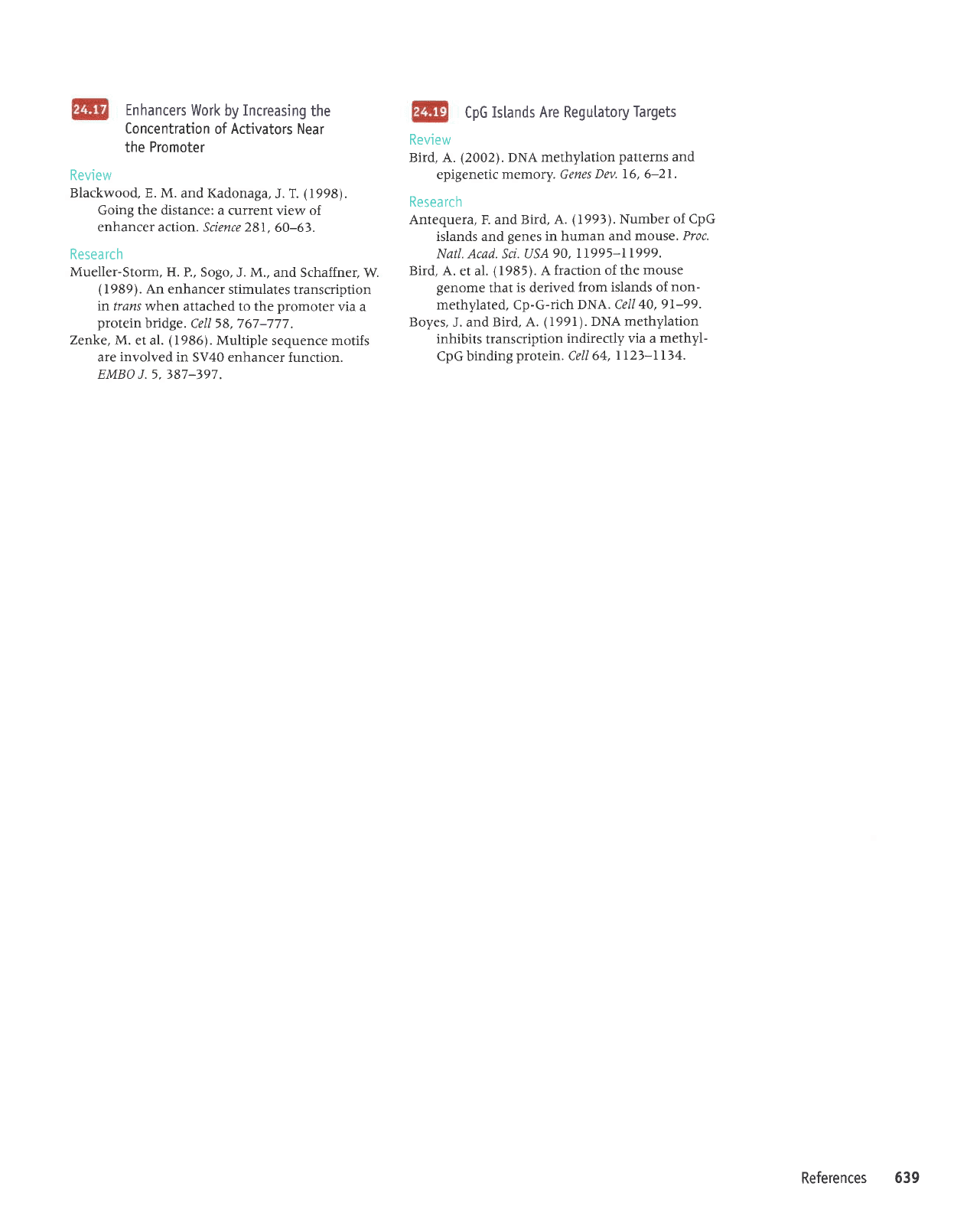
Enhancers
Work
by
Increasing
the
CpG
Islands Are Regulatory
Targets
Concentration
of Activators Near
the
Promoter
Review
Blackwood, E. M.
and I(adonaga,
J.
T.
(1998).
Going the distance: a
current view of
enhancer action. Science 281,
6O-6j.
Resea
rch
Mueller-Storm,
H. P., Sogo,
J.
M.,
and Schaffner,
W.
(
1989). An enhancer
stimulates
transcription
in trans when
attached to the
promoter
via a
protein
bridge. CeIl 58, 7
67
-777
.
Zenke, M. et al.
(
1986). Multiple
sequence motifs
are
involved
in SV40
enhancer function.
EMBO J. 5. 387-397.
Review
Bird, A.
(20021.
DNA methylation
patterns
and
epigenetic
memory. Genes
Dev. 16, 6-21.
Research
Antequera, F. and Bird,
A.
(I99)l
. Number
of CpG
islands and
genes
in human and
mouse. Proc.
Natl. Acad. Sci. USA
90, 11995-11999.
Bird, A.
et al.
(1985).
A fraction
of the
mouse
genome
that
is
derived
from
islands of
non-
methylated, Cp-G-rich
DNA. Cel/
40, 9l-99.
Boyes,
J. and
Bird, A.
(1991).
DNA
methylation
inhibits
transcription
indirectly
via
a
methyl-
CpG binding
protein.
Cell
64,
ll23-lli4.
References
639
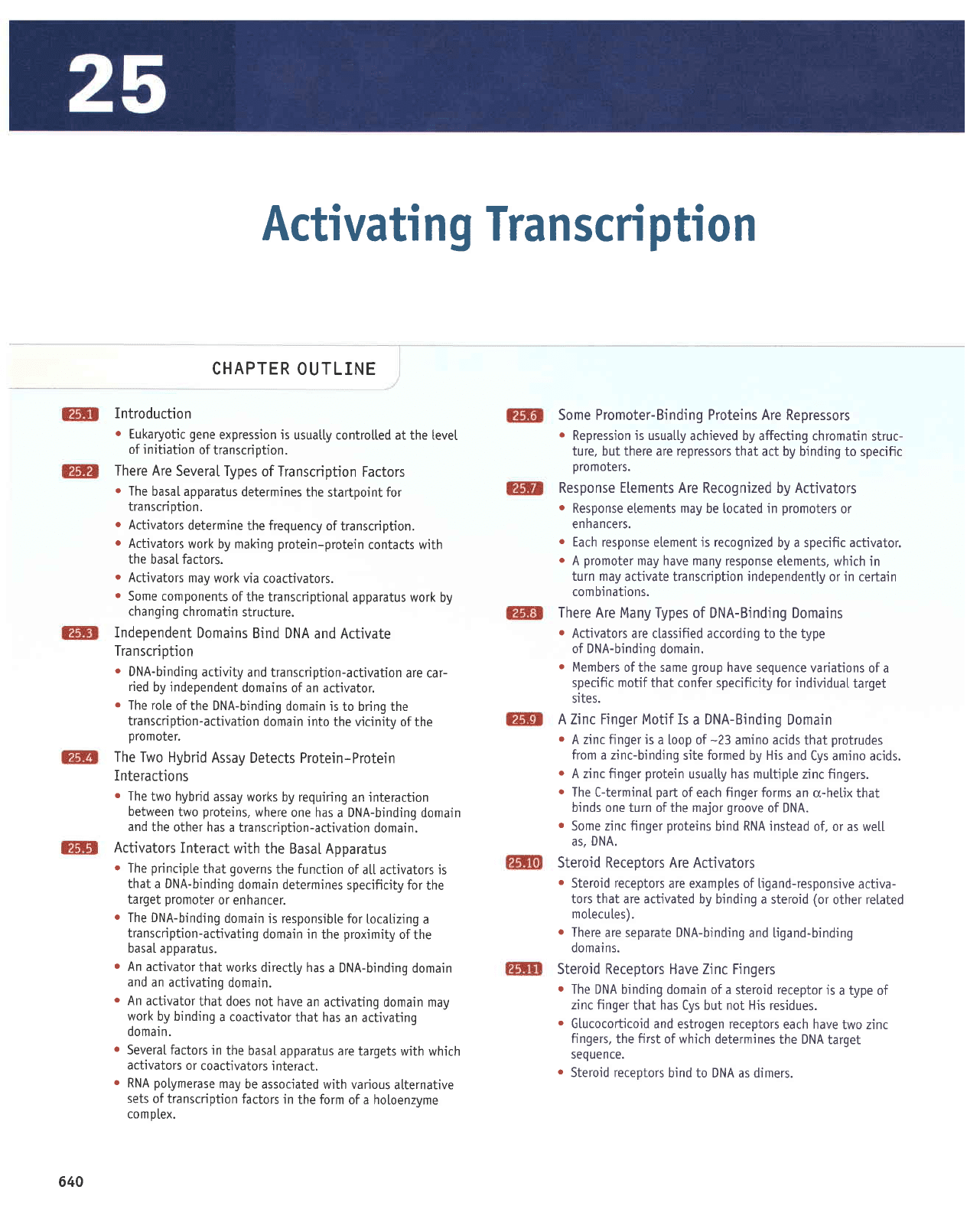
Activati
n
g
Tran
scri
pti
on
CHAPTER
OUTLINE
Introduction
r
Eukaryotic
aene
expression
'is
usually controtted at the [eve[
of initiation
of
transcription.
There Are
SeveraI Types
of Transcription
Factors
r
The
basaI apparatus
determines
the startpoint for
transcription.
o
Activators
determine the frequency
of
transcription.
o
Activators
work by making
protein-protein
contacts with
the
basaI factors.
r
Activators
may
work via
coactivators.
r
Some components
of
the transcriptionaI
apparatus work
by
changing
chromatin
structure.
Independent
Domains
Bind DNA
and Activate
Tra nscri
otio n
o
DNA-binding
activity
and transcription-activation
are car-
ried
by independent
domains of an
activator.
.
The ro[e
of the DNA-binding
domain is
to bring the
transcription-activation
domain into
the vicinity of the
promoter.
The
Two Hybrid
Assay
Detects Protein-Protein
Interactio
ns
o
The
two hybrid
assay
works by requiring
an interaction
between
two
proteins,
where one has
a
DNA-binding
domain
and
the other has
a transcription-activation
domain.
Activators
Interact
with
the BasaI Apparatus
r
The
principle
that
governs
the
function
of atl activators is
that
a
DNA-binding
domain
determines
specificity for
the
target
promoter
or enhancer.
o
The DNA-binding
domain
is responsible
for localizing
a
transcription-activating
domain in
the
proximity
of
the
L^--l ---^--r..-
uq)dL dPPdrdLu5.
r
An
actjvator
that works
directly has
a DNA-binding
domain
and
an activating
domain.
r
An
activator
that does not
have an
activating domain may
work
by binding
a coactivator
that has
an activating
domain.
o
Several factors
jn
the basaI
apparatus are
targets with which
activators
or
coactivators interact.
r
RNA
polymerase
may
be associated
with various
atternative
sets
of transcription
factors
in
the
form
of a holoenzyme
complex.
Some
Promoter-Binding Proteins Are
Repressors
r
Repression is usuatly
achieved by affecting chromatin
struc-
ture, but there
are
repressors
that act by binding
to specific
promorers.
Response E[ements Are
Recognized by Activators
.
Response
etements
may
be [ocated in
promoters
or
en
nancers.
o
Each response element is recognized
by a specific activator.
o
A
promoter
may have
many response elements,
which in
turn may
activate transcription independently
or
in
certajn
combi nations.
There Are
Many Types of DNA-Binding Domains
r
Activators
are classified according to the type
of DNA-binding
domain.
r
Members
of the same
group
have
sequence variations
of a
specific motif that confer specificity for individuaI
target
sites.
A Zinc Finger Motif Is
a
DNA-Binding
Domain
r
A zinc finger is
a loop of
-23
amino acids
that
protrudes
from a zinc-binding
site formed by His and
Cys amino
acids.
r
A zinc finger
protein
usua[[y
has
multipte zinc fingers.
o
The C-terminal
part
of each finger forms
an cr,-heUx that
binds one turn of the major
groove
of DNA.
.
Some zinc finger
proteins
bind RNA instead
of. or as wetl
as,
DNA.
Steroid Receptors Are Activators
.
Steroid receptors
are examptes of ligand-responsive
activa-
tors that are actjvated
by binding a steroid
(or
other related
molecules).
o
There
are separate DNA-binding
and ligand-binding
domains.
Steroid Receptors Have Zinc Fingers
r
The DNA
binding domain of a
steroid
receptor
is
a type of
zinc finger
that has Cys
but
not His
residues.
.
Gtucocorticoid
and estrogen receptors
each have
two zinc
fingers,
the
first
of which determines
the DNA
target
sequence.
r
Steroid receDtors
bind to DNA as dimers.
640
